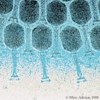 The faint glow from a single molecule combined with a stretch from “magnetic tweezers” could help scientists get a grip on how viruses that infect bacteria, so-called bacteriophages pack up their DNA. The research could lead to a resurgence of interest in the West for a potent treatment for infection that uses bacteriophages instead of antibiotics to attack disease-causing bacteria. The treatment side-steps the problem of bacteria evolving resistance to antibiotics because the agent of bacterial death can evolve just as quickly to cope with any defences put up by the bacteria.
The faint glow from a single molecule combined with a stretch from “magnetic tweezers” could help scientists get a grip on how viruses that infect bacteria, so-called bacteriophages pack up their DNA. The research could lead to a resurgence of interest in the West for a potent treatment for infection that uses bacteriophages instead of antibiotics to attack disease-causing bacteria. The treatment side-steps the problem of bacteria evolving resistance to antibiotics because the agent of bacterial death can evolve just as quickly to cope with any defences put up by the bacteria.
In the face of deadly emergent bacteria such as Escherichia coli O157, multiple-resistance Staphylococcus aureus (MRSA) and Clostridium difficile, there is renewed interest in this alternative to antibiotics. The same study might also lead to new insights into how to combat viruses that infect people too, including herpes and adenoma viruses.
Many viruses use a self-assembly stage in which a powerful molecular motor packs their genetic code into the viruses’ preformed protein shell, its capsid. Now, Carlos Bustamente and colleagues at the University of California, Berkeley, have demonstrated that the genetic code is not coiled up like so much spaghetti on a fork but is packed using a concertina type approach. You can find out more about the details of this work in the current news round-up on SpectroscopyNOW.com